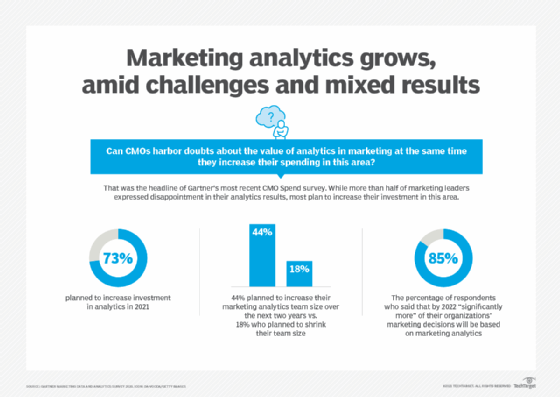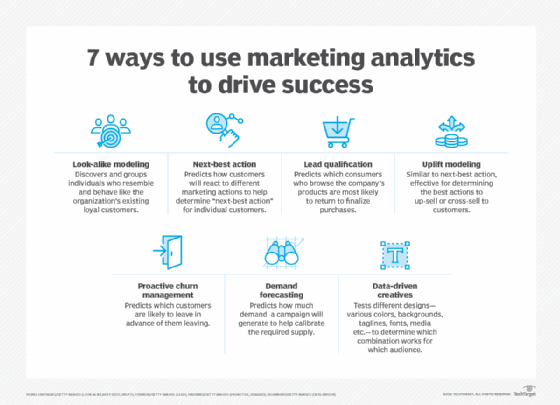Predictive analytics in marketing: Achieving success
The use of predictive analytics in marketing is transforming how companies sell to customers, but the learning curve can be steep. Here's what you need to know to be successful.
Faced with shrinking budgets, marketing departments are under more pressure than ever to maximize results and optimize every dollar spent. According to Gartner, marketing budgets dropped to just 6.4% of company revenue, down from 11% in 2021, the lowest level recorded since the research firm began tracking the metric in 2014.
Predictive analytics, a type of advanced analytics using statistical techniques, machine learning and other tools, can help companies make the most of their marketing dollars.
"This is where companies use different signals from the customers and markets they work in to understand what messaging, communications, offers and products make sense," explained Chirag Shah, associate professor in the Information School at the University of Washington.
What is predictive analytics in marketing?
Business analytics, which includes the field of business intelligence, uses a variety of techniques to identify meaningful patterns in current and past data that can in turn help companies understand what happened, why something happened, what might happen and what should be done next to optimize outcomes.
Predictive analytics, as its name denotes, is the branch of advanced analytics that forecasts what is likely to happen based on patterns in the collected data. The incorporation of artificial intelligence techniques such as machine learning into predictive analytics tools now allows companies to analyze massive quantities of data at great speed, boosting the accuracy and usefulness of predictive models. In fact, many present-day users of predictive analytics tools refer to them simply as machine learning or data science.
 P. K. Kannan
P. K. Kannan
Many industries as well as multiple functional areas within any given organization use predictive analytics. Marketing was an early adopter of the technology and remains one of the most significant users of predictive analytics to help pinpoint which customers to target at what times through which channels with what kind of messages to produce the greatest effect.
"Predictive analytics is widely used in marketing, for segmenting and targeting and acquiring and retaining customers, for determining what kinds of ads to show and which would be most effective to show customers," said P. K. Kannan, dean's chair in marketing science at the University of Maryland Robert H. Smith School of Business.
While marketing has long availed itself of predictive analytics, the extent of its use varies by company, he noted.
Larger and digitally mature companies with the resources and, just as important, the volume of data required for effective use of predictive analytics, are best positioned to take advantage of it. Meanwhile, smaller companies with limited budgets to hire the experienced marketers, data scientists, consultants and technologists required for advanced analytics often have smaller marketing analytics programs.
Organizations entering new markets or launching new products and services that lack historical data (known as a cold start problem) face more challenges to deploying predictive analytics, experts said.

Why is predictive analytics in marketing important?
Analyzing data in order to forecast future behavior and events is a classic example of data-driven decision-making in business. Using predictive analytics removes doubt, guesswork and intuition -- and the corresponding inaccuracies that go with those -- by identifying for executives the most probable outcomes.
As a result, business leaders can have more confidence that the decisions they make will lead to the end results they seek.
For marketing, that means organizations are better positioned to spend their budgets more effectively, experts said, whether they're seeking to convert potential customers into new ones, retain existing ones, target consumers based on their customer lifetime value or create personalized customer experiences.
 Janet Balis
Janet Balis
"More and more marketing leaders are building predictive analytics into their data strategies because it helps them drive efficiency and success," said Janet Balis, marketing practice leader at the professional services firm EY.
Predictive analytics lets marketers "listen to more interesting and more complex signals from customer insights to inform a precision marketing strategy," Balis said. "It's about stimulating demand with precision."
How does predictive marketing work?
Predictive analytics tools, whether in marketing or other functional areas, all basically work the same way: They intake data -- the more the better -- then analyze that data using statistical modeling and machine learning algorithms to uncover patterns in that data.
Using insights about past behaviors, the tools further analyze the data using predictive modeling techniques to forecast likely outcomes in the future.
For example, the analytics system may use a decision tree algorithm, one of the most popular predictive modeling techniques, to determine courses of actions and the statistical probabilities associated with each of the actions; the branches of the decision trees show the possible outcomes of the various decisions and how one action would lead to the next, considering a whole range of variables.
Having your own data is important. "You can buy third-party data for identification purposes mostly, or for whom to target," Kannon said. "But if you want to do predictive modeling, you're taking all the variables you have about the customer and linking them to their actions. So you want data on your own variables. That's what lets you do the predictive analysis that then lets you know the actions customers are going to take with you."
 Chirag Shah
Chirag Shah
Marketing and analytics experts said marketers can choose from a number of off-the-shelf predictive analytics tools with machine learning and AI built in.
However, Shah explained that the more advanced marketing operations often build their own algorithms and custom tools, seeing it as a way to differentiate their efforts and maximize the success for their own organizations.
"It almost also becomes a proprietary thing. For many companies the way they derive their insights is the 'secret sauce,'" he said.
But an in-house proprietary approach to predictive analytics can be costly, he warned, and not every organization will be able to afford it.
Options to developing in-house expertise include hiring agencies that specialize in marketing and analytics services; hiring consultants to help build in-house predictive analytics; or outsourcing analytics to a service provider.

Examples of predictive analytics in marketing
Marketing uses predictive analytics to acquire new customers, retain existing customers and maximize sales.
Key predictive analytics use cases that drive marketing success include the following:
- Look-alike modeling. A key task for marketing departments is to acquire new customers, especially ones who will be long-term customers, and do so efficiently. The aim is to get a healthy return on investment for their marketing efforts, Kannan said. In look-alike modeling, marketers use algorithms to predict which individuals out of a group are most likely to be customers and, even more specifically, long-term customers. Analytics engines sift through data to discover and group those individuals who most resemble and will behave most like the organization's existing loyal customers.
- Next-best action. Based on a wide range of data sets on customers and past behaviors, algorithms in this approach predict how a customer will react to different marketing actions that could be taken so the next-best action can be taken. This allows marketers to determine the follow-on marketing efforts that are likely to yield the best results, minimizing dollars that would be wasted implementing ineffective or less effective campaigns. Balis noted that this capability also helps break down the silos of marketing dollars, which historically have allocated spending in different, isolated categories such as retail displays and promotional campaigns without a lot of coordination between the groups.
- Lead qualification. Marketers can use data to predict which consumers browsing their products are most likely to return to finalize purchases. "You use analytics to predict which are the best leads for your company," Kannon said. That knowledge allows them to target marketing messages to those individuals rather than launching broad campaigns aimed at all browsers -- a costly endeavor that has a lower return.
- Uplift modeling. Similar to next-best action, algorithms in uplift modeling crunch data on current customers as well as past consumer responses to marketing efforts to predict how today's consumers will respond to various marketing offers. The aim is to answer questions like, "Should I give this particular promotion to customer A or to customer B? Which customers should I target with coupons and which shouldn't I waste my money on?" This type of modeling is also effective for determining the best actions to up-sell or cross-sell to customers -- essentially getting them to buy additional items beyond their originally targeted purchase, Balis added.
- Proactive churn management. Predicting which customers are likely to leave in advance of them actually leaving allows marketers to intervene and try to retain those customers, Shah said. He noted that this proactive churn management is particularly crucial for streaming services whose business model is based on constantly engaging customers. Predictive analytics combined with prescriptive analytics lets marketers determine which course of action is the most effective for retaining customers in danger of leaving.
- Demand forecasting. Demand forecasting lets marketers accurately predict how much demand their campaigns will generate so they can ensure they have enough of their products or services at the right locations to meet the expected demand.
- Data-driven creatives. Predictive analytics helps marketers decide how best to target customers. It can also help in tailoring their creative content to the various demographics and locations they serve. "You can use analytics to be just as targeted with the creative, to see what is the best creative [content] for compelling a consumer to take an action," Balis explained. Predictive analytics enables marketers to test different designs -- various colors, backgrounds, taglines, fonts, etc. -- to determine which combination works most effectively for which audience in which media. "You can test versions to get to the optimal one," Balis added.
How to use predictive analytics in marketing successfully
Marketers have a range of readily available off-the-shelf technology tools that enable them to use predictive analytics to shape their marketing campaigns and their overall marketing strategies. In fact, Balis noted that many marketers don't realize how embedded the capability is within the marketing technologies they're routinely using. But she and other experts said deploying the technology itself will not guarantee success. Some tips include the following:
- Focus on having as much data, and as much of the right data, as possible.
- Choose the right algorithms and modeling techniques for the job.
- Have processes to reduce biases introduced by faulty algorithms or incomplete or imbalanced training data.
"We don't have a lack of tools now. We also don't have a lack of data, although a new business or a business going into a new market might not have enough of the right data, but even that eventually stops being a problem," Shah explained.
Building the wrong model, or misinterpreting it, however, remains a problem for many organizations.
"That happens by not looking at the fundamental relationship among the variables you're using," Shah explained.
For example, the model's recommendations could be based on correlation rather than causality. "If you have [the wrong] assumptions and build those into the models, the models will be inaccurate.
Another pitfall "is when all variables are not considered or where there are intervening variables that are ignored," he said.







